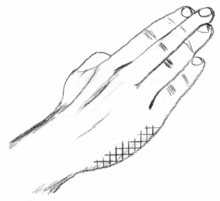Knifehand strike
| Knifehand strike | |||||||
 | |||||||
| Korean name | |||||||
|---|---|---|---|---|---|---|---|
| Hangul | 손날목치기 | ||||||
| |||||||
| Japanese name | |||||||
| Kanji | 手刀打ち | ||||||
| Hiragana | しゅとううち | ||||||
| |||||||
In martial arts, a knifehand strike is a strike using the part of the hand opposite the thumb (from the little finger to the wrist), familiar to many people as a karate chop (in Japanese, shutō-uchi).[1][2] This refers to strikes performed with the side of the knuckle of the small finger. Suitable targets for the knifehand strike include the mastoid muscles of the neck, the jugular, the throat, the collar bones, ribs, sides of the head, temple, jaw, the third vertebra (key stone of the spinal column), the upper arm, the wrist (knifehand block), the elbow (outside knifehand block), and the knee cap (leg throw).[3]
In many Japanese, Korean and Chinese martial arts systems, the knifehand is used to block as well as to strike.
Japanese martial arts
Tegatana (手刀 : てがたな, Japanese for hand-sword) is a term from Japanese martial arts like aikido and Chinese-Okinawan martial arts like karate referring to a hand position that resembles that of the blade of a sword. This can be in a high, middle or low position but is usually extended outwards at about eye level (towards the carotid artery and nerve – a key strike point).[4]
During practice, uke and tori will often stand opposite each other with their respective tegatana touching each other. From this position, considered by some the ideal combative distance for two unarmed opponents, many balance-breaking, striking and throwing techniques can be applied. In karate, the handsword collarbone chop (tegatana-sakotsu-uchi), the handsword collarbone strike (tegatana-sakotsu-uchikomi) and the handsword face chop (tegatana-ganmen-uchi) all use this fundamental strike as a basis for attack.[5]
The knife hand strike can be used with both sides of the hand. Having the thumb tucked in, leaving the fore finger side of the hand free, allows that side of the hand to be used as a striking surface. This is called a inside knife hand where as the pinkie finger side is called outside knife hand.[6]
Korean martial arts
In taekwondo a knifehand strike (sonkal taerigi) is executed by striking with the muscle at the side of the hand located between the base of the small finger and the wrist (abductor digiti minimi).[7] It is used as both an offensive and defensive technique and can be executed as a high, low, middle, side, inward, outward, rising or circular strike. Use of this technique as both a strike and block is featured prominently in many of the WTF Taegeuk poomse.[8][9]
Fictional depictions
The popularity of martial arts in the mid to late 20th century gave rise to an exaggerated version of a knifehand strike widely used in American and British cinema, television, and animated cartoons. In common depictions, a character will deliver a single, precise-looking but relatively weak strike to the side of an opponent's neck, which instantly renders them unconscious but otherwise unharmed (in some versions, the blow is instantly fatal). This is frequently done from behind to an unaware adversary, often an enemy guard. The move became a staple of the spy genre through the 60s and 70s.[10] For example, the saboteur, Dr. Zachary Smith, used a knifehand strike to incapacitate or kill (fans debate which) a security guard during the first episode the '60's space adventure series 'Lost in Space'.
References
- ↑ "Black Belt - Google Books". Books.google.co.uk. Retrieved 2015-03-10.
- ↑ "Black Belt - Google Books". Books.google.co.uk. Retrieved 2015-03-10.
- ↑ "Black Belt - Google Books". Books.google.co.uk. Retrieved 2015-03-10.
- ↑ "Ju-No-Kata - Keiko Fukuda - Google Books". Books.google.co.uk. Retrieved 2015-03-11.
- ↑ "Biomechanics of Human Motion: Applications in the Martial Arts - Emeric Arus, Ph.D. - Google Books". Books.google.co.uk. 2012-12-13. Retrieved 2015-03-11.
- ↑ "Mas Oyama's Classic Karate - Mas Oyama - Google Books". Books.google.co.uk. Retrieved 2015-03-11.
- ↑ "Tae Kwon Do: Secrets of Korean Karate - Sihak Henry Cho - Google Books". Books.google.co.uk. Retrieved 2015-03-10.
- ↑ "Taegeuk-sah-jang (taegeuk 4) Free Taekwondo Patterns Videos". Taekwondo-information.org. 2013-05-11. Retrieved 2015-03-10.
- ↑ "Advanced Taekwondo - Scott Shaw - Google Books". Books.google.co.uk. Retrieved 2015-03-10.
- ↑ "Hong Kong Film, Hollywood and New Global Cinema: No Film is An Island - Google Books". Books.google.co.uk. 2007-01-24. Retrieved 2015-03-10.
Bibliography
- Mas Oyama, Mas Oyama's Essential Karate, Fourth Publishing, 1980, Sterling Publishing Co., Inc.
| ||||||||||||||||||||||||||||||||||||||||||||||||||||||